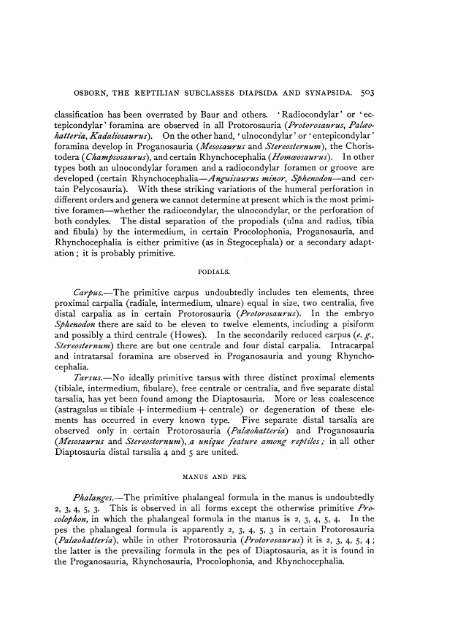American Museum of Natural History
American Museum of Natural History
American Museum of Natural History
Create successful ePaper yourself
Turn your PDF publications into a flip-book with our unique Google optimized e-Paper software.
OSBORN, THE REPTILIAN SUBCLASSES DIAPSIDA AND SYNAPSIDA. 503<br />
classification has been overrated by Baur and others. 'Radiocondylar' or 'ectepicondylar'<br />
foramina are observed in all Protorosauria (Pro/orosaurus, Palceoha/leria,<br />
Kadaliosaurus). On the other hand, 'ulnocondylar' or 'entepicondylar'<br />
foramina develop in Proganosauria (Mesosaurus and Slereos/ernum), the Choristodera<br />
(Chamfisosaurus), and certain Rhynchocephalia (Homceosaurus). In other<br />
types both an ulnocondylar foramen and a radiocondylar foramen or groove are<br />
developed (certain Rhynchocephalia-Anguisaurus minor, Sphenodon-and certain<br />
Pelycosauria). With these striking variations <strong>of</strong> the humeral perforation in<br />
different orders and genera we cannot determine at present which is the most primitive<br />
foramen-whether the radiocondylar, the ulnocondylar, or the perforation <strong>of</strong><br />
both condyles. The distal separation <strong>of</strong> the propodials (ulna and radius, tibia<br />
and fibula) by the intermedium, in certain Procolophonia, Proganosauria, and<br />
Rhynchocephalia is either primitive (as in Stegocephala) or a secondary adaptation;<br />
it is probably primitive.<br />
PODIALS.<br />
Cafrpus.-The primitive carpus undoubtedly includes ten elements, three<br />
proximal carpalia (radiale, intermedium, ulnare) equal in size, two centralia, five<br />
distal carpalia as in certain Protorosauria (Prolorosaurus). In the embryo<br />
Sphenodon there are said to be eleven to twelve elements, including a pisiform<br />
and possibly a third centrale (Howes). In the secondarily reduced carpus (e. g.,<br />
Slereosternum) there are but one centrale and four distal carpalia. Intracarpal<br />
and intratarsal foramina are observed in Proganosauria and young Rhynchocephalia.<br />
Tarsus.-No ideally primitive tarsus with three distinct proximal elements<br />
(tibiale, intermedium, fibulare), free centrale or centralia, and five separate distal<br />
tarsalia, has yet been found among the Diaptosauria. More or less coalescence<br />
(astragalus = tibiale + intermedium + centrale) or degeneration <strong>of</strong> these elements<br />
has occurred in every known type. Five separate distal tarsalia are<br />
observed only in certain Protorosauria (Palcohaleria) and Proganosauria<br />
(Mesosaurus and Slereos/ernum),.a unique feature among rep/fies; in all other<br />
Diaptosauria distal tarsalia 4 and 5 are united.<br />
MANUS AND PES.<br />
Phalanges.-The primitive phalangeal formula in the manus is undoubtedly<br />
2, 3, 4, 5, 3. This is observed in all forms except the otherwise primitive Procolophon,<br />
in which the phalangeal formula in the manus is 2, 3, 4, 5, 4. In the<br />
pes the phalangeal formula is apparently 2, 3, 4, 5, 3 in certain Protorosauria<br />
(Palatoha//eria), while in other Protorosauria (Pro/orosaurus) it is 2, 3, 4, 5, 4;<br />
the latter is the prevailing formula in the pes <strong>of</strong> Diaptosauria, as it is found in<br />
the Proganosauria, Rhynchosauria, Procolophonia, and Rhynchocephalia.

















